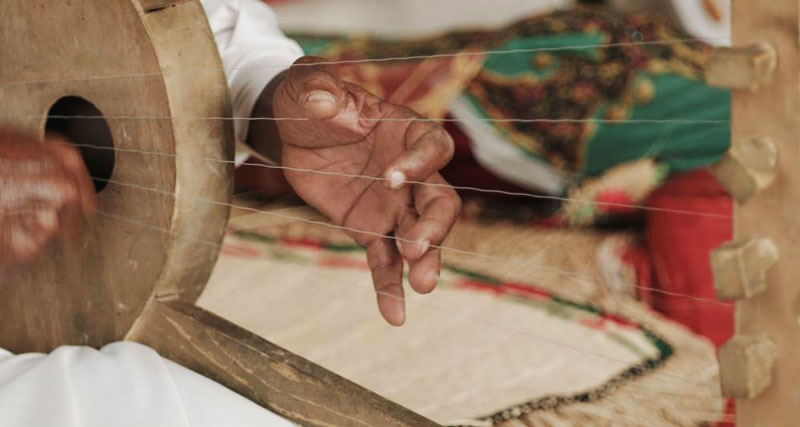(headline image: The number of semsemia strings on Farasan Island © Talal Ayeel, Saudi Arabia, 2023)
The semsemiah (also known as sensemia, semsemeya or simsimiyya) is an ancient harp-like traditional stringed instrument played and crafted in communities along the Suez Canal in Egypt and the Red Sea coast of Saudi Arabia. Recognized in 2024 on UNESCO’s Representative List of the Intangible Cultural Heritage of Humanity, it serves as both a musical and social medium, fostering cultural expression and community cohesion.
In terms of structure, the semsemiah consists of a wooden triangular frame with a crossbar where metal strings are stretched. The number of strings varies, ranging from five to twelve in Egypt, influencing the instrument’s sound. Crafted using beechwood or metal, often from natural or recycled materials, its construction takes approximately six days.

The crafting process is traditionally handled by the players themselves, though some dedicated artisans refine its design while maintaining traditional specifications. In Egypt, both men and women participate in crafting innovations, while in Saudi Arabia, local craftsmen ensure its continuity.

The instrument is integral to musical performances at concerts, national celebrations, weddings, and cultural festivals. It is widely played by musicians, singers, and composers, as well as fishermen and sailors who incorporate it into maritime traditions.
- Egypt: The semsemiah is central to various folk music groups, including El Tanborah and Welad El Bahr in Port Said. It accompanies traditional performances and maintains historical relevance in social and political movements.
- Saudi Arabia: It is played in Jeddah, Jizan, Farasan Islands, and Yanbu, often in combination with percussion and wind instruments. Local musicians personalize their instruments, attributing symbolic names linked to personal emotions and heritage.
Transmission and Education
The skills of playing and crafting the semsemiah are passed down through informal oral traditions within families and performance groups.
- Egypt: The instrument is also formally taught through workshops, training programs, and in institutions such as the High Institute of Folklore.
- Saudi Arabia: The internet and social media have emerged as key tools for learning, supplementing community-based instruction.


Preservation Efforts and Institutional Support
Communities, NGOs, and government entities have implemented measures to safeguard the semsemiah, ensuring its continued practice.
Egypt:
- NGOs such as El Mastabah Association and the Semsemiah Buds School promote awareness and training.
- Digital platforms, including social media groups and YouTube channels, document performances.
- A semsemiah museum in Suez preserves instruments and historical materials.
- Government-backed workshops and competitions encourage younger generations to learn the craft.
Saudi Arabia:
- The Saudi Arabian Society for Culture and Arts supports musicians with resources and performance opportunities.
- National events, such as the Al Janadriyah Festival, feature semsemiah performances.
- The Virtual Academy for Music Education and Music Hubs offer structured learning for new players.
- The Heritage Commission’s “Torouq Al-Saudia” initiative actively preserves traditional music, including semsemiah.


The semsemiah remains a vital cultural element in both Egypt and Saudi Arabia, sustained through traditional practices, institutional support, and digital adaptation.


